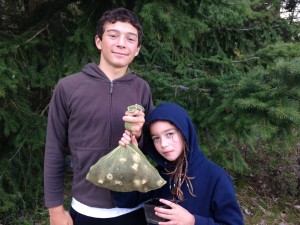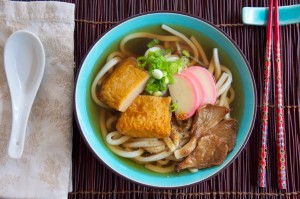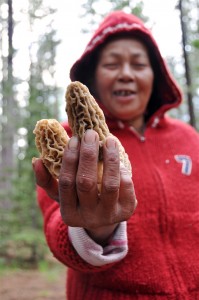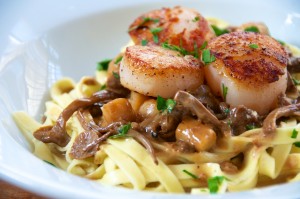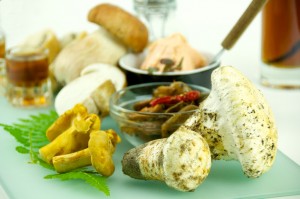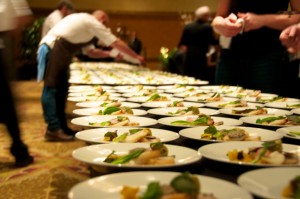
I’ve already blocked out the dates on my 2015 calendar. The last weekend in January is truffle time, which means the first few weeks of the new year are a time of belt-tightening.

I’m talking about the annual Oregon Truffle Festival, which will be celebrating its 10th anniversary next year. I hear there are big plans afoot for 2015, so in order to be ready, I might need to join my parents on January 1 when they “put on the hair shirt.” Putting on the hair shirt entails cutting out all alcoholic beverages and rich foods for three weeks. They don’t last the full month because, according to them, their social schedule begins to heat up again in the last week of January. As does mine.
I look forward to the Oregon Truffle Festival every year. I’ve made friends who I know I’ll see that weekend, and only that weekend. They come from all over the country and abroad. Those of you who have read The Mushroom Hunters know that an entire chapter takes place at the festival. My editor would have been happy to see a whole book from there; he needs to get on a plane to Oregon.
This year’s lineup was pretty amazing. Karen Page and Andrew Dornenburg, authors of the James Beard award-winning books The Flavor Bible and What To Drink with What You Eat, were guest dignitaries (not to mention charming tablemates), and they helmed a tasting—along with Lee Medoff of Bull Run Distilling, beer guru Christian DeBenedetti, and wine writer Cole Danehower—that pushed the usual boundaries: three flights—wine, beer, and spirits—paired with truffled bites. I have to say, I was pleasantly surprised to see how well an Oregon Vesper Cocktail (Medoyeff vodka, Aria gin) paired with a White Truffle and Duck Liver Mousseline. Whodathunkit?

The first course of Saturday night’s Grand Truffle Dinner (pictured above), by Aaron Barnett of St. Jack in Portland, also involved the apparently now hip spirit pairing. Oregon White Truffle Cured Beef Tenderloin with Celery, Oregon Black Truffle, and Oyster Emulsion was nicely matched with a Celery Gimlet devised by St. Jack’s John Salas. I’m not a big cocktail drinker, but these pairings proved fresh and tasty.

The Grand Truffle Dinner was over the top as always, with everyone donning their finest attire (ahem, Mr. Winkler at right, with his turkey-tail tie). Pictured at the top of this post is the first course, created by Justin Wills of Restaurant Beck in Depoe Bay on the Oregon Coast, receiving its finishing touches: Oregon Black Truffle Chirashi with Dungeness Crab, Kampachi, Cured Scallop, Yuzu, Takawan, and Oregon Black Truffle Tamago (it helps to have a smart phone at table just to look up such ingredients!). Another unusual hit was the Chawanmushi of Foie Gras with Oregon White Truffles, served up by Hero Sone and Lisa Doumani of Terra in Napa Valley.

Thankfully I was going into this six-course feast with an appetite. Earlier that day I saw the beginnings of a new Périgord truffle orchard at Domaine Meriwether. (Just add water and wait 10 years!) Planted by New World Truffieres, the small plot is something of an experimental orchard, with several varieties of host tree that will be grown organically (no weed killers!) and subjected to new ideas in this otherwise very old business. Later at lunch, the winery served Beef Tartare with Black Truffle Mayonnaise, Micro Greens & Crostini (pictured above left), another of my favorites of the weekend, and paired with their excellent 2001 Brut Rosé. After that we worked off lunch with a walk in the woods. For those who wanted to take home some truffles, this was a good year. Everyone got a chance to forage their own with the help of Umami Truffle Dogs.
Now it’s time to put the hair shirt on.

Like this:
Like Loading...
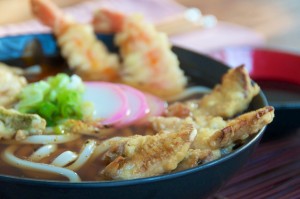 Spot shrimp (Pandalus platyceros) rank among the great delicacies my region is known for. They’re excellent tempura battered and fried, and make a good addition to udon.
Spot shrimp (Pandalus platyceros) rank among the great delicacies my region is known for. They’re excellent tempura battered and fried, and make a good addition to udon.



